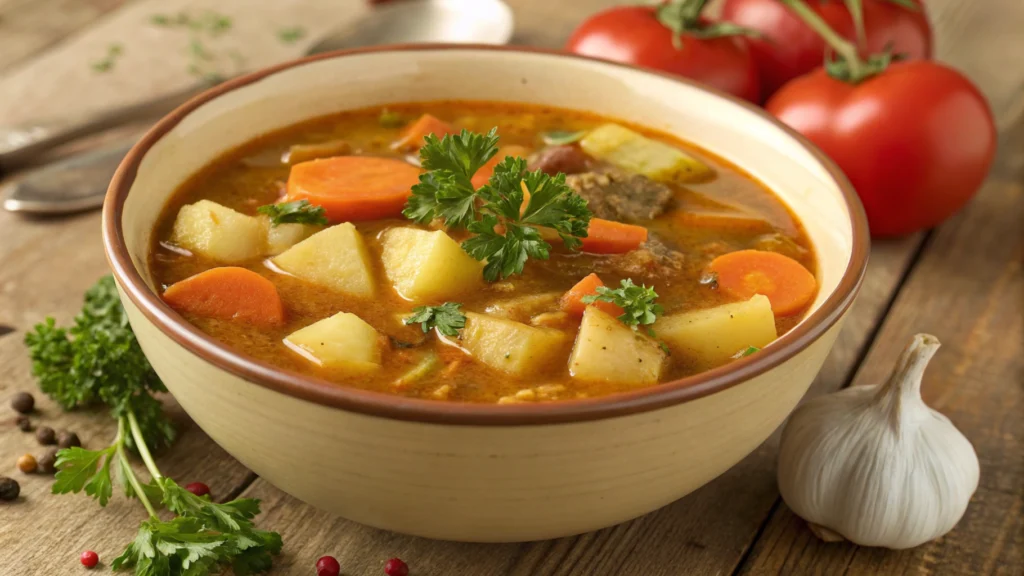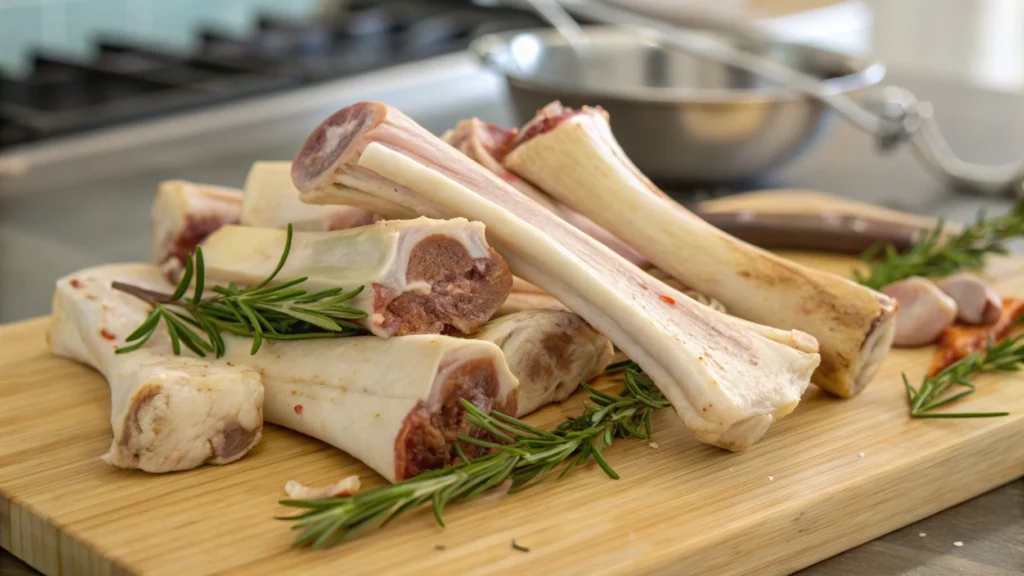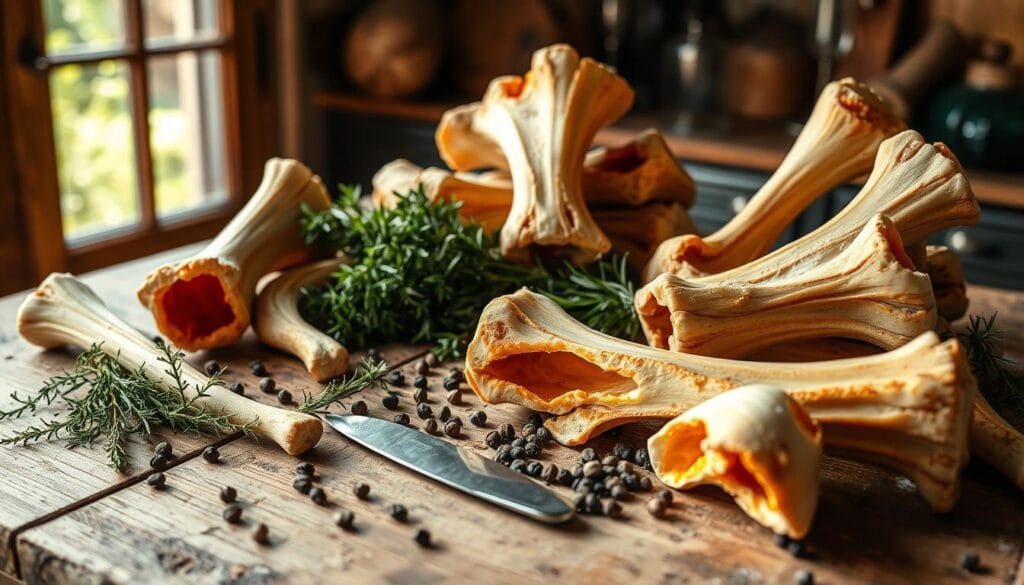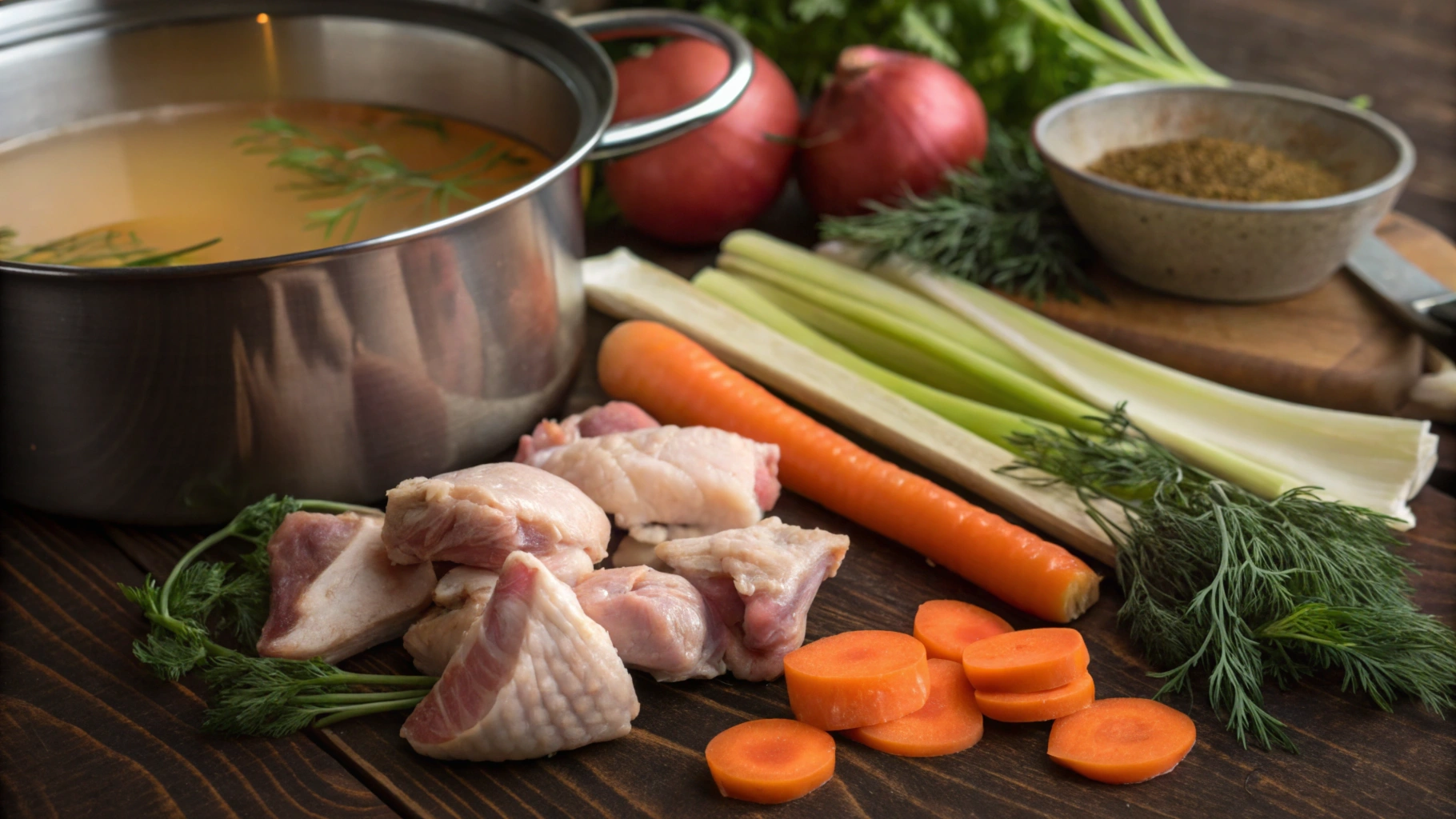As you hold a warm mug of bone broth, its heat and smell take you back to cozy childhood moments. This classic drink, made from simple soup bones, has fed and comforted people for ages. It’s still loved today for its taste and health benefits.
Table of contents
Bone broth has been a key part of our diet for thousands of years. It’s full of flavors and nutrients. Making your own broth can make your cooking better and help you stay healthy.
Choosing the right soup bones is key to making great broth. Chicken bones are common, but beef, pork, or a mix can add more flavor. Each type of bone adds its own taste and health benefits.
Chicken wings, backs, necks, and feet are great for chicken lovers. Beef fans should try knuckles, marrow bones, and neck bones. Pork enthusiasts can use neck bones and feet for a rich broth.
The secret to great bone broth is in the bones and how you prepare them. Pressure cookers can make broth in 4 hours, but slow cooking is best. It takes 24 to 48 hours for the best flavor.
Understanding the Nutritional Value of Bone Broth
Bone broth is known for its rich nutrients. It’s a flavorful liquid that brings many health benefits. Adding it to your diet can be very beneficial.
Essential Minerals and Nutrients
Bone broth is full of important minerals and nutrients. A single cup has about 50 calories. It also has potassium and sodium, which are essential for our bodies.

Protein Content and Amino Acids
Bone broth is high in protein. An 8-ounce cup of chicken broth has about 10 grams of protein. This is great for those who want more protein without extra calories.
Collagen and Joint Health Benefits
The collagen in bone broth is good for our joints. Drinking it regularly may help with joint pain. It also supports liver health and helps reduce stress.
| Nutrient | Amount per Cup | Benefit |
|---|---|---|
| Calories | 50 | Low-calorie option |
| Protein | 9g | Supports muscle health |
| Potassium | 280mg | Aids in fluid balance |
| Sodium | 450mg | Supports hydration |
Bone broth offers more than just minerals and protein. It also has compounds that can improve gut health and skin health. Whether you choose beef, chicken, or fish bones, each type has unique benefits for your wellbeing.
Types of Soup Bones for Premium Broths
Making a tasty soup stock begins with picking the right bones. There are many choices, each with its own benefits. Let’s look at the most common types of soup bones and what they offer.

Beef marrow bones are loved for their creamy centers. They make a broth that’s full of nutrients. Knuckle bones, meanwhile, are great for broths that are smooth and gelatin-rich.
Chicken bones are a lighter option. Use them after roasting a whole chicken for a broth that’s both delicate and flavorful. Fish bones can also be used, making a milder stock that’s perfect for seafood dishes.
“The secret to a great soup lies in the bones you choose. Each type brings its own unique flavor profile to the pot.” – Chef Amanda Lee
When picking soup bones, here’s what to consider:
| Bone Type | Flavor Profile | Nutrient Content | Best Used For |
|---|---|---|---|
| Beef Marrow Bones | Rich, beefy | High in fat and minerals | Hearty soups, stews |
| Knuckle Bones | Mild, gelatinous | High in collagen | Thick broths, sauces |
| Chicken Bones | Light, versatile | Balanced minerals | Light soups, risottos |
| Fish Bones | Delicate, marine | Rich in omega-3 | Seafood bisques, chowders |
The quality of your bones is key. Choose grass-fed beef bones or free-range chicken bones for better nutrients. With these choices, you can make premium broths that take your cooking to the next level.
Selecting Quality Marrow and Knuckle Bones
Choosing the right bones is key for a rich, flavorful broth. Look for quality and source to get the most nutritional benefits.
Grass-fed vs. Conventional Bones
Grass-fed soup bones are better than conventional ones. They have more monounsaturated fats, making the broth buttery and flavorful. These soup bones also contain omega-3 and omega-6 fatty acids, which are good for brain health and reducing inflammation.
| Bone Type | Benefits | Best Use |
|---|---|---|
| Grass-fed Bones | Higher nutrient content, better flavor | Premium broths, health-focused recipes |
| Conventional Bones | More affordable, widely available | Everyday cooking, basic broths |
Fresh vs. Frozen Bone Options
Freshness is important when picking bones. Fresh bones smell clean and look moist, without drying or cracking. While fresh is best, frozen bones are a good backup. Choose marrow bones from femur and shin for the most flavor.

Sourcing Quality Bones
Finding top-quality bones takes some work, but it’s worth it. Here are places to find organic bones:
- Local farmer’s markets
- Butcher shops specializing in grass-fed meats
- Health food stores with meat departments
- Online retailers offering organic meat products
- Local farms that sell direct to consumers
Getting bones from trusted sources is crucial for the best broth. Always ask about the bones’ origin and quality.
Preparation Techniques for Maximum Flavor
Learning how to make bone broth is essential for great taste. It involves roasting, cleaning, and cooking bones to make a broth full of flavor and nutrients.
Roasting Methods
Roasting bones is a key step in making bone broth. Heat your oven to 450°F. Roast the bones and veggies for 30-40 minutes. This step caramelizes the surface, making the broth taste richer.
Proper Cleaning and Storage
Before cooking, wash the bones under cold water. Take off any extra fat or tissue. Keep fresh bones in the fridge for up to 3 days or freeze for later. Storing bones properly keeps your broth ingredients safe and of high quality.
Optimal Cooking Times
For the best broth, simmer it for 12-24 hours at low heat. This long cooking time pulls out all the nutrients and flavors. Add garlic, bay leaves, and peppercorns in the last 3 hours to add more taste without overpowering the broth.
| Cooking Step | Time Frame |
|---|---|
| Roasting bones and vegetables | 30-40 minutes at 450°F |
| Simmering bone broth | 12-24 hours over low heat |
| Adding aromatics | Last 3 hours of cooking |
| Skimming foamy bits | First hour of cooking |
Don’t forget to remove any foam that forms in the first hour. This makes your broth clear and clean-tasting. By using these steps, you’ll make a delicious and healthy bone broth. It’s great for drinking or as a base for other dishes.
Essential Ingredients and Aromatics
Making a tasty bone broth begins with picking the right bones. These bones are simmered for a long time, often 48 hours. This long cooking time pulls out important nutrients, gelatin, and minerals.
Aromatics are key to a great broth flavor. Onions, garlic, and celery are common choices. They add depth and complexity. Fresh herbs like parsley, thyme, and bay leaves add aromatic oils to the broth.
Spices are important for unique flavors. Paprika, cumin, and turmeric add taste and health benefits. Mixing different spices lets you get creative with your broth.
Adding sea vegetables like kelp or kombu boosts minerals. Wild mushrooms like chaga or reishi add flavor and health benefits to your broth.
| Ingredient | Function | Cooking Time |
|---|---|---|
| Bones | Primary source of nutrients | Up to 48 hours |
| Apple Cider Vinegar | Helps extract minerals | Entire cooking process |
| Aromatics (onions, garlic, celery) | Flavor enhancement | 1-2 hours |
| Herbs and Spices | Flavor and potential health benefits | Last 30-60 minutes |
The quality of your ingredients matters a lot. Choose grass-fed bones if you can. Always use fresh produce for the best homemade bone broth.
Common Mistakes to Avoid When Making Bone Broth
Making bone broth is a craft that needs careful attention. Many home cooks make mistakes that can ruin the broth. Let’s look at some common errors and how to avoid them.
Temperature Control Issues
Keeping the right temperature is key for extracting nutrients and flavor. Boiling can make the broth reduce too fast and ingredients mushy. For a rich broth, cook at 98°C for chicken and 95-96°C for beef for 16-18 hours.
Seasoning Errors
Seasoning broth right is an art. Too much salt can ruin it. Use simple sea salt and add it slowly. Avoid adding strong-tasting veggies like broccoli or cabbage, as they can overpower the broth.
Storage Missteps
Storing broth properly is vital. Cool it before freezing and use the right containers to avoid freezer burn. Straining is key for a clear broth. Longer cooking times don’t always mean better quality.
| Bone Type | Bones to Water Ratio | Cooking Time |
|---|---|---|
| Chicken | 1.4:2 | 16-18 hours |
| Chicken Feet | 1:2 | 16-18 hours |
| Beef | 1:2 (varies) | 16-18 hours |
Skim off foamy bits every 20 minutes in the first hour for a clear broth. By avoiding these mistakes, you’ll make a tasty and healthy bone broth. For more cooking tips and recipe guidelines, check out our website.
Storage and Preservation Methods
Proper storage of bone broth keeps its flavors and health benefits alive for months. Freezing is the best way to keep it fresh at home. You can keep it in the fridge for up to 7 days. But for longer, freezing is the way to go.
Freezing requires using straight-sided mason jars, plastic containers, or ice cube trays for small portions. Make sure to leave an inch of space for expansion. This makes it easy to store and portion.
To keep the broth at its best, store it at -18°C (0°F) or lower. Vacuum-sealed bags can keep it good for up to 6 months. Open bags should be used in 1 to 2 months. Cool the broth to room temperature before freezing to avoid bacterial growth.
| Storage Method | Duration | Temperature |
|---|---|---|
| Refrigerator | Up to 7 days | 4°C (40°F) or below |
| Freezer | 3-6 months | -18°C (0°F) or below |
| Deep Freezer | Up to 1 year | -23°C (-10°F) or below |
For keeping broth at room temperature, pressure canning is needed. Water bath canning doesn’t work for bone broth because it’s not acidic enough. By using these methods, your homemade bone broth will stay fresh and full of nutrients for later use.
Conclusion
Homemade bone broth is packed with health benefits and uses in cooking. It boosts collagen levels, which is good for your skin, bones, and joints. This can help with skin health, stronger bones, and better joint function for those with osteoarthritis.
Beyond collagen, bone broth has more perks. It might help you sleep better, reduce inflammation, and ease symptoms of ulcerative colitis. It’s also full of minerals like calcium, magnesium, and potassium, making it very nutritious. Bone broth has been known to support the immune system and help with recovery from illnesses like the flu for centuries.
In the kitchen, bone broth is a great addition. You can use it as a base for soups, stews, and sauces, or drink it on its own. To get the most out of it, use high-quality ingredients and follow proper preparation. Always talk to a healthcare professional before adding bone broth to your diet, especially if you have health concerns.
FAQs
What are the best types of bones for making bone broth?
Beef marrow bones, knuckle bones, and chicken bones are top choices. Beef bones give a rich flavor. Chicken bones, especially from roasted whole chickens, are also great. Marrow and knuckle bones are rich in nutrients.
How long should I simmer bone broth?
Simmer beef bones for 24-36 hours. Use a crockpot on low or an oven roaster at 200-225°F. This long time extracts nutrients and flavors well.
What are the nutritional benefits of bone broth?
Bone broth is packed with protein, about 8-10 grams per cup. It also has minerals like calcium and magnesium. These nutrients are easy to digest. But, some claims about its benefits might be too good to be true.
Should I roast the bones before making broth?
Yes, roasting bones before simmering boosts flavor. Roast raw bones at 400°F for an hour. Then, scoop out the marrow for extra nutrients.
Where can I source quality bones for bone broth?
Look for bones at local butcher shops, farmers markets, or grocery stores. Opt for grass-fed or organic for more nutrients. Raw milk providers and Weston A. Price Foundation chapters can also help.
What ingredients should I add to my bone broth?
Use bones, water, apple cider vinegar, and aromatics. Add vegetables like onions and carrots for flavor and nutrients. Herbs and spices enhance taste. Garlic, ginger, and turmeric are good for health.
How should I store bone broth?
Store in the fridge for up to 7 days or freeze for 3-6 months. Cool it to room temperature before freezing. Use glass jars, leaving the top off for 24 hours to prevent cracking.
Is the collagen in bone broth beneficial?
Bone broth is known for collagen, but it’s not very bioavailable. Still, its protein and amino acids help your body make collagen.
What are some common mistakes to avoid when making bone broth?
Avoid wrong temperatures, which harm nutrients and flavor. Don’t over-season or store improperly. Strain well and store correctly to keep quality and safety.
Can I use bone broth in cooking?
Yes, bone broth is versatile. Use it as a soup base, for cooking grains, or in marinades. It adds flavor and nutrients to many dishes.


15 thoughts on “Best Soup Bones for Rich and Flavorful Homemade Broths”